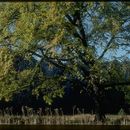More info for the terms:
cover,
swampAmerican elm is common on wet flats and bottomlands but is not
restricted to these sites. In the southern bottomland regions, it
commonly occurs on terraces and flats but not in deep swamps. At higher
elevations in the Appalachians it is often limited to the vicinity of
larger streams and rarely occurs at elevations above 2,000 feet (610 m).
In the Lake States and Central States, it is found on plains and moraine
hills as well as the bottomlands and swamp margins. Along the
northeastern edge of its range, it is usually restricted to valleys
along waterways except where it has been planted on the uplands
[
29,
42,
50].
American elm grows best on rich, well-drained loams. Growth is poor on
dry sands and where the summer water table is constantly high. In
Michigan, on loam and clay soils, growth is good when the summer water
table drops 8 to 10 feet (2.4-3.0 m) below the surface. In the South,
American elm is common on clay and silty-clay loams on bottomlands and
terraces. Growth is medium on wetter sites and good on well-drained
sites. In the arid western end of its range, American elm is restricted
to silt or clay loams in river bottoms and terraces. American elm most
commonly grows on soils of the orders Alfisols, Inceptisols, Mollisols,
and Ultisols [
5,
29,
41].
In addition to those species mentioned in SAF Cover Types, common
associates of American elm include balsam fir (Abies balsamea), silver
maple (Acer saccharinum), sycamore (Platanus occidentalis), pin oak
(Quercus palustris), black tupelo (Nyssa sylvatica), white ash (Fraxinus
americana), sweetgum (Liquidambar styraciflua), hackberry (Celtis
occidentalis), boxelder (Acer negundo), birch (Betula spp.), and hickory
(Carya spp.) [
4,
19,
43,
50].

